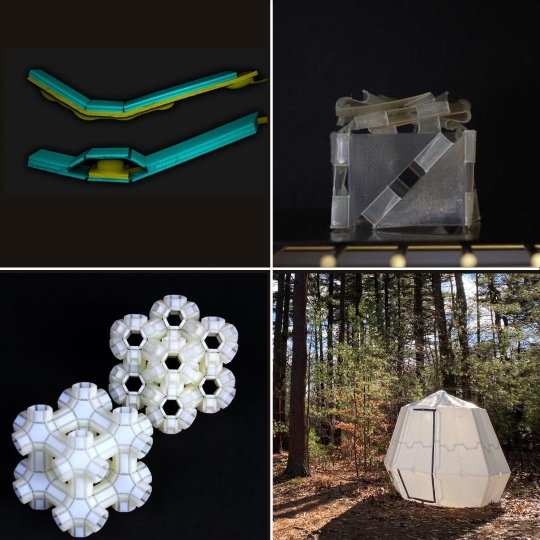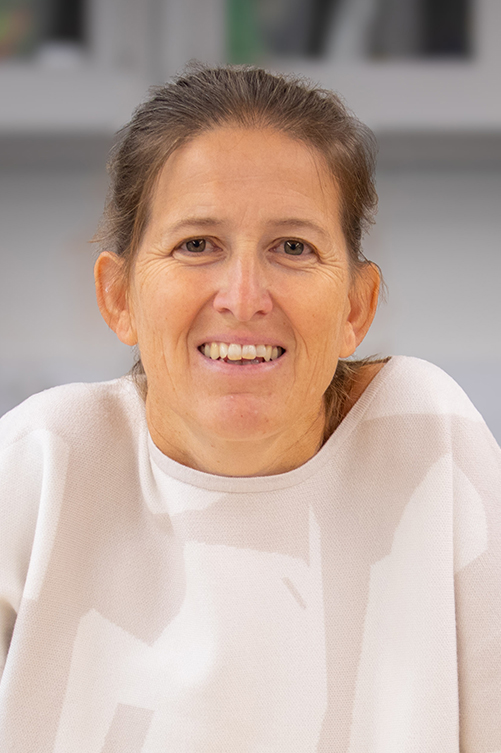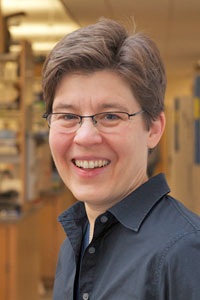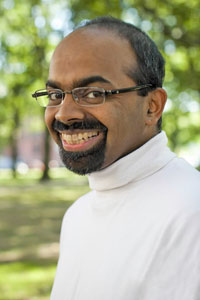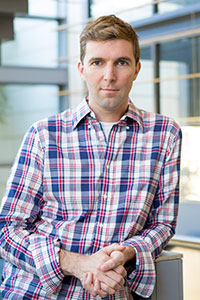News
Examples of origami- and kirigami-inspired multifunctional structures include hybrid soft pop-up actuators (top left), 3D-printed soft robotic systems (top right), transformable materials (bottom left) and inflatable shelters (bottom right). (Credit: Harvard SEAS)
Key Takeaways
-
A Harvard-led team, headed by Katia Bertoldi, won a $6.25M Department of Defense MURI award to research origami- and kirigami-inspired multifunctional structures.
-
The project will develop lightweight, multi-stable materials capable of shifting between shapes for applications like adaptable robots, collapsible antennae, rapid-deploy bridges, temporary shelters, and protective gear.
-
The interdisciplinary team combines expertise in mathematics, physics, materials science, mechanics, and robotics to create new design models, manufacturing methods, and experimental platforms that merge flexibility, strength, and adaptability.
------------------------------------------------------------------------------------------------------
An interdisciplinary team of researchers led by Katia Bertoldi, the William and Ami Kuan Danoff Professor of Applied Mechanics at the Harvard John A. Paulson School of Engineering and Applied Sciences (SEAS), has been awarded $6,250,000 from the Department of Defense (DoD) as part of the 2022 Multidisciplinary University Research Initiative (MURI) awards
The highly competitive MURI program supports teams of investigators pursuing basic research spanning multiple scientific disciplines with the goal of facilitating the growth of newly emerging technologies to address the DoD’s unique problem sets.
This year, the DoD awarded $195 million to 28 research teams across the country. In addition to Bertoldi, the team includes SEAS faculty Jennifer Lewis, the Hansjorg Wyss Professor of Biologically Inspired Engineering; L. Mahadevan, the Lola England de Valpine Professor of Applied Mathematics, of Organismic and Evolutionary Biology, and of Physics; and Robert Wood, the Harry Lewis and Marlyn McGrath Professor of Engineering and Applied Sciences. The team also includes Eleni Katifori, of the University of Pennsylvania and David Zeb Rocklin, of the Georgia Institute of Technology.
The researchers will be exploring a new class of origami- and kirigami-inspired flexible, lightweight structures capable of transitioning between many stable shapes to perform different tasks or adapt to changing environmental conditions. These structures could be used in a range of applications, from multifunctional robots and collapsible antennae to rapidly assembled bridges and temporary structures, and force protection elements like origami inspired bulletproof shields.
“Our team combines experts in mathematics, physics, material science, mechanics, robotics, numerical modeling, and computation, giving us a set of skills that is essential for the successful execution of this ambitious research program,” said Bertoldi.
The researchers aim to combine those skill sets to develop a set of mathematical models to characterize and design the complex mechanical behavior of multi-stable origami and kirigami structures; new scale-spanning manufacturing processes that efficiently integrate actuation and sensing; and experimental test beds to serve as a platform for evaluation and optimization of design concepts.
"Our essential mission is to program as many stable shapes and deformation modes into these sheets as possible by synthesizing geometry, materials and robotics,” said Zeb Rocklin, Assistant Professor at the Georgia Institute of Technology, and co-PI of the project whose group has pioneered analytic frameworks for deformations of flexible structures. "Our team is going to apply a tight collaborative cycle between theory and experiment to realize practical devices that embody universal mathematical laws. With this talented team, we have a tremendous opportunity to create new structures that efficiently generate flexibility and strength."
The project builds upon previous research and field-leading expertise in multifunctional, origami- and kirigami-inspired structures at SEAS, including bistable pop-up structures, foldable robots, untethered soft robotic materials, and transformable metamaterials.
“By supporting teams whose members have diverse sets of expertise, the MURI program acknowledges that the complexities of modern science and engineering challenges often intersect more than one discipline and require creative and diverse approaches to tackle these problems,” said Bindu Nair, Director, Basic Research Office, Office of the Undersecretary of Defense for Research and Engineering. “This cross-fertilization of ideas can accelerate research progress to enable more rapid R&D breakthroughs and hasten the transition of basic research findings to practical application.”
Kirigami-inspired research developments
Follow the evolution of kirigami-inspired research at Harvard SEAS at this link.
Topics: Awards, Kirigami, Materials, Materials Science & Mechanical Engineering
Cutting-edge science delivered direct to your inbox.
Join the Harvard SEAS mailing list.
Scientist Profiles
Katia Bertoldi
William and Ami Kuan Danoff Professor of Applied Mechanics
Jennifer Lewis
Hansjorg Wyss Professor of Biologically Inspired Engineering
L Mahadevan
Lola England de Valpine Professor of Applied Mathematics, of Organismic and Evolutionary Biology, and of Physics
Robert J. Wood
Harry Lewis and Marlyn McGrath Professor of Engineering and Applied Sciences
Press Contact
Leah Burrows | 617-496-1351 | lburrows@seas.harvard.edu
